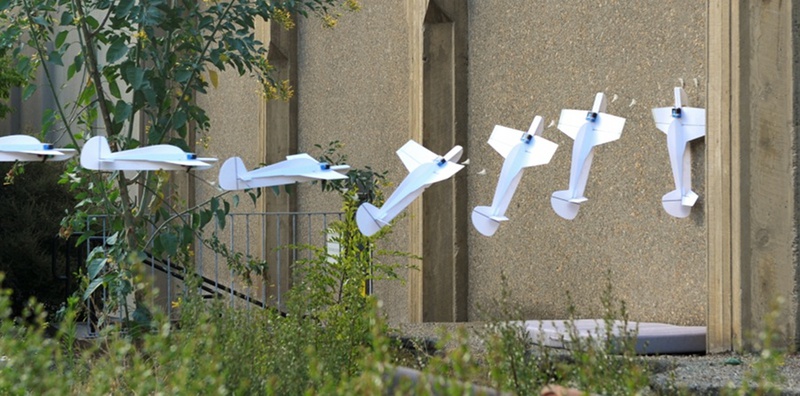Wall mounted aircraft, jumping glider and quadrocopter on the ceiling

In the laboratory of bionics at Stanford University are engaged in the creation of unusual aircraft. The first is an unmanned aircraft with the unique ability to land on vertical surfaces and take off from them. Instead of a chassis, it has thin springy “legs” with sharp claws that allow you to catch on any rough surface.
It looks primitive, these claws are the product of lengthy experiments and computer simulations. Their length and elasticity are carefully selected for a perfect fit. Each claw works independently of the others, which allows the foot to cling much more reliably.
But the main role in the ability to sit on the wall is played by the onboard computer. For a successful landing it is necessary to make a very accurate maneuver. A split second sooner or later - and the plane falls, failing to cling to the wall.
')
The plane also takes off from the wall. Having relaxed the claws, for the first few seconds it is held in the air due to the thrust of the screw, and at the same time gaining speed, flying upside down from the wall. Then he flips into the normal position.
Another aircraft capable of clinging like a fly to a wall and even to the ceiling is a quadrocopter sticking to surfaces due to the forces of Van der Waals. Its “dry velcro” works on the same principle as the gecko's foot. It does not contain either suckers or glue, but adheres to any, both smooth and rough surface only due to the mechanical structure of the legs. They contain billions of microscopic villi just a few hundred nanometers thick. These villi increase the adhesion area of the paws to the surface by many orders of magnitude, as a result of which the intermolecular van der Waals forces arising at very small distances become capable of supporting considerable weight. In addition, they can be very thin and quickly controlled - the gecko's foot is able to stick and peel off the surface up to 15 times per second.
In the Stanford laboratory of bionics for several years now they have been developing the Stickybot robot , created in the image of a gecko. The experience gained in creating his paws is now transferred to the aircraft. Airplanes and quadcopters capable of landing not only on horizontal platforms, but also on the walls of houses, trees, rocks, can be widely used in reconnaissance vehicles, in rescue work in natural disaster sites, to observe nature. If you place photocells on the wings of an aircraft, it will be able to work autonomously for a long time even without having a safe level platform for taking off and landing, “resting” on trees and rocks.
The ability to make quick and accurate maneuvers required for takeoffs and landings on walls and ceilings can be useful for maneuvering in cramped conditions, and for creating vehicles that use planning in conjunction with other methods of movement in space. So, another project of the same laboratory is a jumping glider. Flying squirrels and flying fish became its prototypes in wildlife. They are not capable of a long flight, but due to their aerodynamics they can make long jumps. This method of movement is more effective than ordinary jumps or running, it allows you to overcome very large obstacles and ensures a soft landing when jumping from any height.
The experimental apparatus makes a jump at the expense of the spring, and at the top point brings the wings to the working position, descending along a long, flat path. Although due to the additional aerodynamic drag of the wings, the height of the trajectory is slightly lower than that of the control apparatus with the same weight and energy of the jump, the length to be overcome is about one and a half times longer. Download a PDF with an article describing experiments with a jumping glider in detail here .
Source: https://habr.com/ru/post/183466/
All Articles